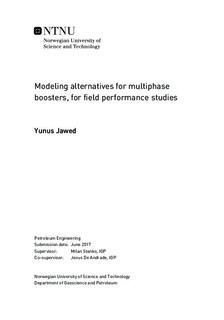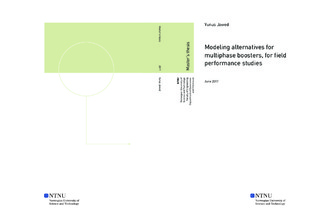| dc.description.abstract | The concept selection for the development of a petroleum field critically depends upon the uncertainties involved in the field performance analysis, and any deviation in the actual field production from the originally estimated production rates may change the risk to the investment. Predicting the throughput of the fields is related with the performance of the equipment selected in the field architecture. Low energy or depleting fields require artificial pressure boosting for throughput sustenance. In comparison with conventional single-phase boosters, a multiphase booster may alleviate the need of extensive subsea processing equipment but its uncertain performance and inadequate performance prediction models becomes the major source of uncertainty, when predicting the boosted production profile. In commercial production simulator, the user typically must choose a specific booster model from the database; but the correction methods and the validity range of the model are not fully disclosed. In consequence, the computed production profile may still have a high uncertainty associated.
This thesis explores alternative approaches to model the performance of a multiphase boosters, suitable for the field design phase when computing the production profiles; and presents a framework for automated selection of an optimum booster by honouring all constraints of the field. Two test cases were employed: The Snøhvit field and the Draugen field. In the Snøhvit field s case, as no booster is yet installed, a simplified booster model of a wet gas compressor was developed that requires minimum user input. In the Draugen field, the actual booster model (a helicoaxial booster available in PIPESIM) was employed for the study. In the case of helicoaxial booster, the sensitivity of the boosters performance was checked against varying water-cut and GVF. The approach includes a unique procedure to develop an empirical equation, that generates iso-speed performance map of the booster by processing the data obtained from PIPESIM. For automated booster selection, an Ms Excel utility was prepared that takes field data as an input, and yields the best possible booster along with the feasible operational configuration. Such utility can reduce the booster selection time consumed during manual checking the applicability of the different boosters available in the commercial simulators.
The procedure followed to obtain the coefficients of the equation to generate iso-speed maps can further be analysed to investigate the relation between coefficients value with the fluid s intrinsic properties; as any further success can lead to the development of a numerical model for multiphase boosting process. | |

